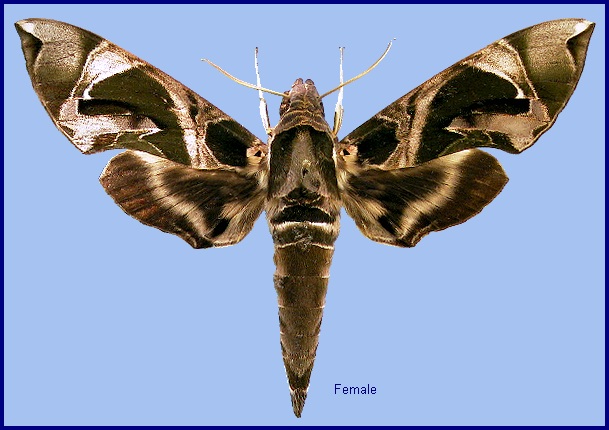
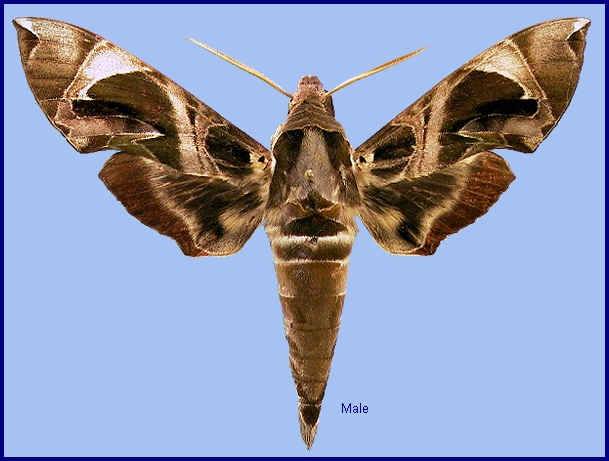
Daphnis hypothous crameri Eitschberger & Melichar, 2010, European Entomologist 2: 67. Type locality: Thailand, Chiang Rai, Wiang Pa Pao, 3.vii.1989.
[Further details on this species in Japan, as well as photos of many stages, can be found on Digital Moths of Japan.]
Wingspan: 86--120mm. Very like a dark Daphnis nerii, but distinguished by a white spot at the forewing apex; head and collar uniformly dark purple-brown, thorax and first two abdominal segments dark green.
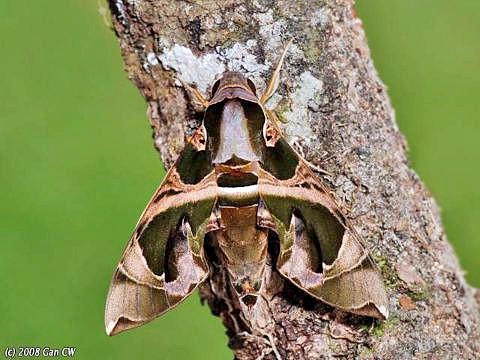
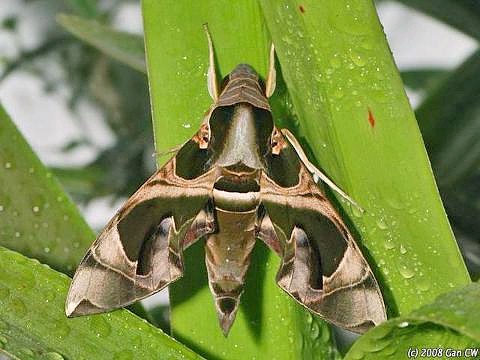
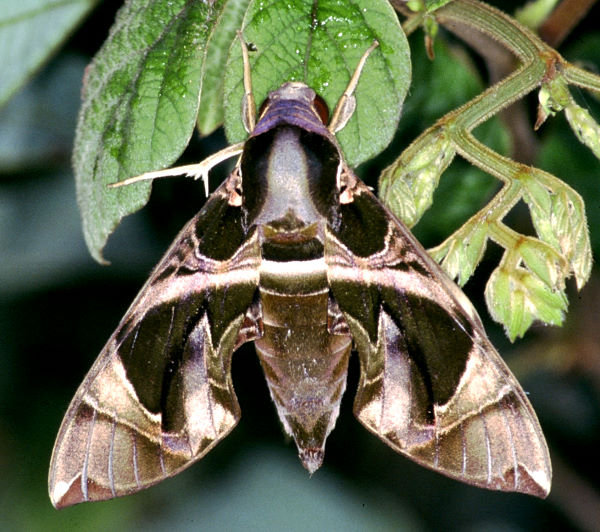
Daphnis hypothous is a very fast flyer, attracted to both sweet-smelling flowers and light, but little else is known of its behaviour.
In Metro-Manila, the Philippines, this synanthropic species has been reported as being active at daybreak and during rainy weather, when it has been observed to drink from water puddles next to roads (Dvořák, 2014).
China: ii (Hong Kong); vi (Shandong); 25.vi (Yunnan); vii-viii (Guangdong); 23.vii-13.viii (Hong Kong); ix-xi (Hong Kong); x (Guangdong). Taiwan: iv-v (Kaohsiung Hsien; Pingtung Hsien); 22-25.vii (Pingtung Hsien); ix (Pingtung Hsien). Japan: viii (Ryukyu Archipelago, Tokushima).
OVUM: Very similar to that of Daphnis nerii.
LARVA: Full-fed 60--100mm. Trichromatic: green, pale reddish-brown or yellow and red. Fully-grown examples from India (Bell & Scott, 1937) are usually apple-green (darker above), the thoracic segments with more yellow than the abdominal segments. A white dorso-lateral line, tinged with cadmium yellow at each end, extends from thoracic segment 2 to the base of the horn, and, on the abdominal segments, is edged with reddish-orange above and with a broken sky-blue line below. Laterally, these segments bear darker green, oblique stripes and yellow dots, with a large, blue eye-spot on thoracic segment 3. Anal claspers brown, edged with yellow. The brown, tubercled horn, unlike that of Daphnis nerii, is fully formed but blunt, stout, erect and slightly curved, similar in appearance to that of A. convolvuli. Although most larvae are green, some may be pale red, or even yellow and red. Before pupation, the whole body assumes a plum colour blotched with dark red.
Occurs on bushes and creepers close to the ground, usually near water.
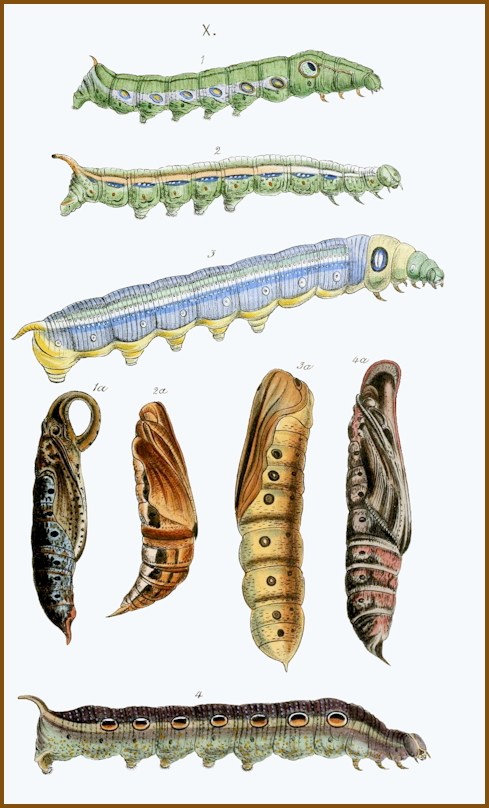

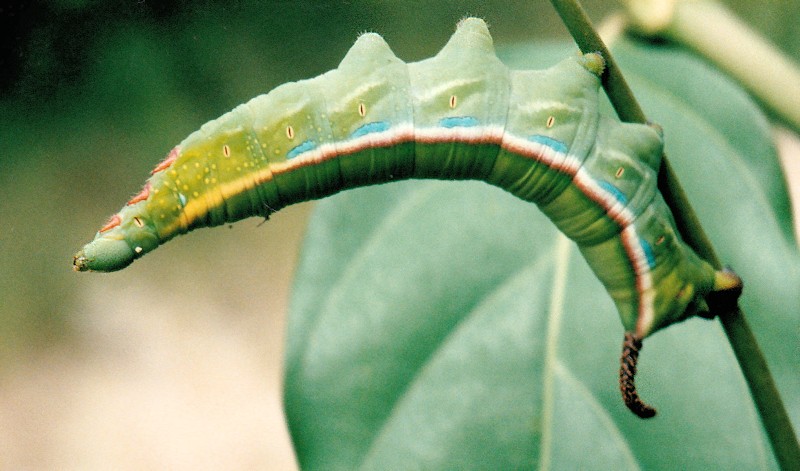
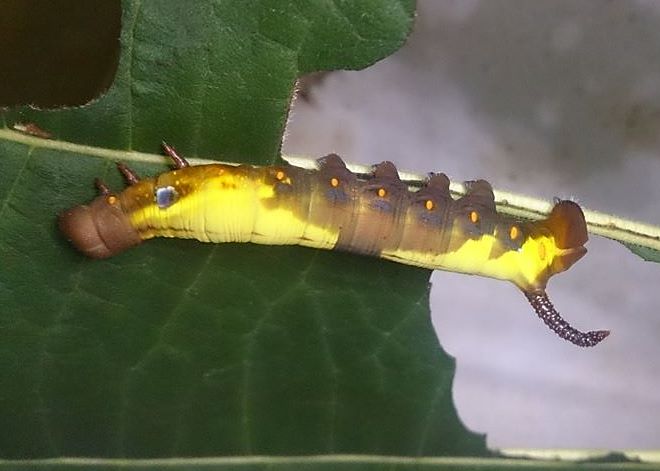
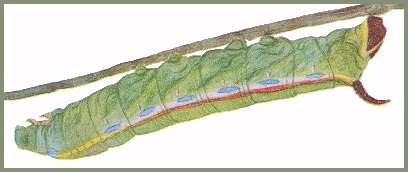
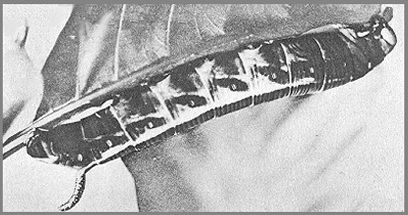
PUPA: 60--80mm. Similar to that of Daphnis nerii, but with a thin black line running along the proboscis, over the head and along the whole dorsal surface, terminating, in this species, in a broad, triangular cremaster tipped with two points. The spiracles are located in a dark lateral band which runs parallel to two others along the ventral surface of the abdomen. Formed in a loosely spun cocoon among debris on the ground. Does not overwinter.
[Illustrated in Eitschberger & Ihle, 2014].
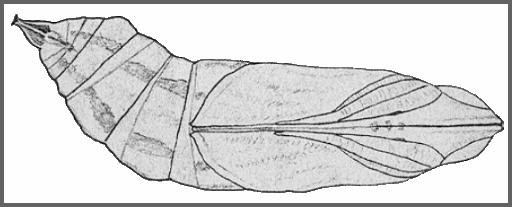

Larval hostplants. Unrecorded for China, but usually found on woody Rubiaceae. Cinchona, Wendlandia and Uncaria have been recoded from India (Bell & Scott, 1937), and Mitragyna rotundifolia from Thailand (Eitschberger & Ihle, 2014). Records for Nerium may be erroneous due to confusion with Daphnis nerii; however, this species has been found on a woody member of the Apocynaceae in Singapore, namely Dyera costulata [syn. Alstonia costulata] (Roger Kendrick/Craig Williams, pers. comm. 2014).
On Taiwan, recorded from Neonauclea reticulata and Uncaria hirsuta (Rubiaceae).
In Metro-Manila, the Philippines, sporadic on various species of ornamental Gardenia (Dvořák, 2014), and in Bhutan on Cinchona, Wendlandia, Uncaria, Alstonia, Anthocephalus, Ixora and Pavetta.
Recorded from Neolamarckia cadamba (Rubiaceae) on Sulawesi (Aras Sandi/Gary Saunders, pers. comm. 2014). This common ornamental and timber tree may turn out to be a major host in India, South East Asia and southern China. Also on Nauclea orientalis (L.) L. in other parts of Indonesia.
[Easily reared in captivity on Symphoricarpos (Gary Saunders, pers. obs. 2017).]
None recorded.
China: Shandong (Weihai); Sichuan; Yunnan (Mengzi; nr. Jinping, 2155m; Pingbian; Gaoligong Shan); Xizang/Tibet (Mutu, Namjagbarwa region, 2190m; Yadong, 2800m); Guizhou (Leishan, 990-1540m; Xinzhaidashan, Zhijin County, 1000-2000m); Hunan; Guangdong (Longtou Shan); Macau; Hong Kong; Hainan (Duowen Ling, nr Lingao; Longhushan, Wenchang City).
Taiwan: Kaohsiung Hsien (Shanping, 640m; Mt. Narumi, 1200m); Pingtung Hsien (Kenting Park); Nantou Hsien (Houfuanshan); Chiayi Hsien (Alishan); Hualien Hsien (Antung; Hungyeh).
Japan: Ryukyu Archipelago (Tokushima).
A migrant to the north of China; the Shandong specimen was captured by T. B. Fletcher (1899) on 23 June 1898. Multi-brooded in the Oriental region.
Sri Lanka, southern and northern India, Nepal, Bhutan (Irungbam & Irungbam, 2019), Burma/Myanmar, Great Nicobar Island (Singh, Ahmad & Chandra, 2021), southern China, Taiwan, the Philippines, Thailand, Vietnam (Le & Vu, 2024), Malaysia and western Indonesia (east to Sulawesi, Timor, Wetan and Tanimbar): a rare vagrant to the western Palaearctic region.
Also, eastern Indonesia (the Moluccan islands of Halmahera, Obi, Bacan, Seram, Ambon, the Kai Islands and probably Buru) as the nominate subspecies Daphnis hypothous hypothous (Cramer, 1780); then New Guinea, the Solomon Islands and northern Australia as the very distinct subspecies Daphnis hypothous moorei (Macleay, 1866) (syn. Daphnis hypothous pallescens Butler, 1875). [The latter is now regarded by many taxonomists as a good species, namely Daphnis moorei (Macleay, 1866).]
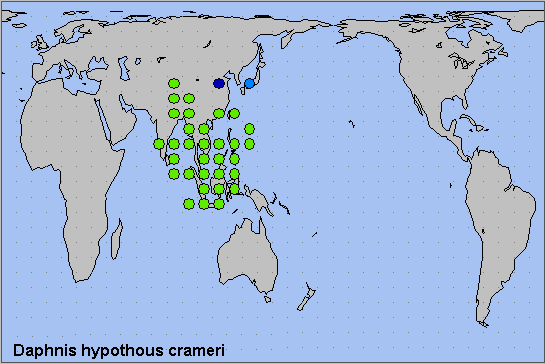
Palaeotropical; Oriental region.
 Return to Sphingidae of the Eastern Palaearctic species list
Return to Sphingidae of the Eastern Palaearctic species list